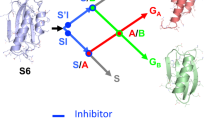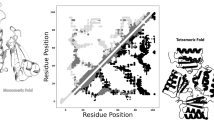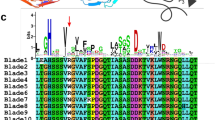Abstract
To determine the role of primary structure in specifying turns, random sequences (guests) were substituted for the native turn sequences in a series of proteins (hosts) of differing thermo-dynamic stabilities.The fraction of inserts that result in active proteins is measured as a function of the stability of the host and temperature. With a highly stable host more than half of the inserts give functional proteins. However, a smaller fraction of sequences supports folding as the stability of the host decreases, and the temperature increases. The sequences of many of the selected inserts resemble the wild-type turn, and those that diverge match other established turn preferences. Thermodynamic measurements show that turn sequences selected under stringent conditions result in the most stable proteins. Thus, β-turns appear to be under evolutionary pressure favouring thermodynamically stable structures.
This is a preview of subscription content, access via your institution
Access options
Subscribe to this journal
Receive 12 print issues and online access
$189.00 per year
only $15.75 per issue
Buy this article
- Purchase on Springer Link
- Instant access to full article PDF
Prices may be subject to local taxes which are calculated during checkout
Similar content being viewed by others
References
Rose, G.D., Gierasch, L.M. & Smith, J.A. Turns in peptides and proteins. Adv. Prot. Chem. 37, 1–109 (1985).
Hynes, T.R., Kautz, R.A., Goodman, M.A., Gill, J.F. & Fox, R.O. Transfer of a β-turn structure to a new protein context. Nature 339, 73–76 (1989).
Predki, P.F., Agrawal V., Trunger, A.T. & Regan, L Amino-acid substitutions in a surface turn modulate protein stability. Nature Struct. Biol. 3, 54–58 (1996).
Wright, P.E., Dyson, J.H. & Lerner, R.A. Conformation of peptide fragments of proteins in aqueous solution: Implications for initiation of protein folding. Biochemistry 27, 7167–7175 (1988).
Milburn, P.J., Konishi, Y., Meiwald, Y.C. & Scheraga, H.A. Chain reversals in model peptides: Studies of cystine-containing cyclic peptides I. Conformational free energies of cyclizationof hexapeptides of sequence Ac-Cys-X-Pro-Gly-Y-Cys-NHMe. J. Am. Chem. Soc. 109, 4486–4496 (1987).
Garrett, J.B., Mullins, L.S. & Raushel, F.M. Are turns required for the folding of ribonuclease T1 ? Prot. Sci. 5, 204–211 (1996).
Helms, L.R. & Wetzel, R. Destabilizing loop swaps in the CDRs of an immunoglobulin VL domain. Prot. Sci. 4, 2073–2081 (1995).
Brunet, A.P. et al. The role of turns in the structure of an oc-helical protein. Nature 364, 355–358 (1993).
Castagnoli, L., Vetriani, C. & Cesareni, G. Linking an easily detectable phenotype to the folding of a common structural motif. Selection of rare turn mutations that prevent the folding of Rop. J. Mol. Biol. 237, 378–387 (1994).
Vlassi, M. et al. Restored heptad pattern continuity does not alter the folding of four α-helix bundle. Nature Struct. Biol. 1, 706–716 (1994).
Viguera, A.R., Blanco, F.J. & Serrano, L. The order of secondary structure elements does not determine the stucture of a protein but does affect its folding kinetics. J. Mol. Biol. 247, 670–681 (1995).
Matthews, B.W. Structure and genetic analysis of protein folding and stability. Curr. Opin. Struct Biol. 3, 589–593 (1993).
Feng, Y. & Sligar, S.G. Effect of heme binding on the structure and stability of Escherichia coli apocytochromeb562. Biochemistry 30, 10150–10155 1991).
O′Neil, K.T., Hoess, R.H., Raleigh, D.P. & DeGrado, W.F. Thermodynamic genetics of the folding of the B1 immunoglobin-binding domain from streptococcal protein G. Proteins, Struct. Funct. Genet. 21, 11–21 (1995).
Sturtevant, J.M. The thermodynamic effects of protein mutations. Curr. Opin. Struct. Biol. 4, 69–78 1994).
Gronenborn, A.M. et al. A novel, highly stable fold of the immunoglobulin binding domain of streptococcal protein G. Science 253, 657–661 (1991).
Gallgher, T., Alexander, P., Bryan, P. and Gilliland, G.L Two crystal structures of the B1 immunoglobulin-binding domain of streptococcal protein G and comparison with NMR. Biochemistry 33, 4721–4729 (1994).
Alexander, P., Fahnestock, S., Lee, T., Orban, J. & Bryan, P. Thermodynamic analysis of the folding of the streptococcal protein G IgG-binding domains B1 and B2: why small proteins tend to have high denaturation temperatures. Biochemistry 31, 3597–3603 (1992).
Sibanda, B.L, Blundell, T.L & Thornton, J.M. Conformation of β-hairpins in protein structures. J. Mol. Biol. 206, 759–777 1988).
Blanco, F.J., Rivas, G. & Serrano, L. A short linear peptide that folds into a native stable beta-hairpin in aqueous solution. Nature Struct. Biol. 1, 584–590 (1994).
Derrick, J. & Wigley, D. Crystal structure of a streptococcal protein G domain bound to an Fab fragment. Nature 359, 752–754 (1992).
Gronenborn, A.M. & Clore, G.M. Identification of the contact surface of a streptococcal protein G domain complexed with ahuman Fc fragment. J. Mol. Biol. 233, 331–335 (1993).
Lian L-Y, Barsukov, I.L., Derrick, J.P. & Roberts G.C.K. Mapping the interactions between streptococcal protein G and the Fab fragment of IgG in solution. Nature Struct. Biol. 1, 355–357 (1994).
Frank, M.K., Clore, G.M. & Gronenborn, A.M. Structural and dynamic characterization of the urea denatured state of the immunoglobulin binding domain of streptococcal protein G by multidimensional heteronuclear NMR spectroscopy. Prot. Sci. 4, 2605–2615 (1995).
Presta, L.G. & Rose, G.D. Helix signals in proteins. Science 240, 1632–1641 (1988).
Richardson, J.S. & Richardson, D.C. Amino acid preferences for specific locations at the ends of alpha helices. Science 240, 1648–1652 (1988).
Sibanda, B.L & Thornton, J.M. β-hairpin families in globular proteins. Nature 316, 170–174 (1985).
Mattos, C., Petsko, G.A. & Karplus, M. Analysis of two-residue turns in proteins. J. Mol. Biol. 238, 733–747 (1994).
Chothia, C. Conformation of twisted beta-pleated sheets in proteins. J. Mol. Biol. 75, 295–302 (1973).
Thornton, J.M., Jones, J.D.T., MacArthur, M.W., Orengo, C.M. & Swindells, M.B. Protein folds: towards understanding folding from inspection of native structures. Phil. Trans. R. Soc Lond. B348, 71–79 (1995).
Shrauber, H., Eisenhaber, F. & Argos P. Rotamers: To be or not to be? An analysis of amino acid side-chain conformations in globular proteins. J. Mol. Biol. 230, 592–612 (1993).
Edelhoch, H. Spectroscopic determination of tryptophan and tyrosine in proteins. Biochemistry 6, 1948–1954 (1967).
Kraulis, P.J. MOLSCRIPT: a program to produce both detailed and schematic plots of protein structures. J. Appl. Crystallogr. 24, 946–950 (1991).
Fahnestock, S.R., Alexander, P., Filpula, D. & Nagle, J. In Bacterial Immunoglobin Binding Proteins Vol. 1 (Boyle, M.P.D., ed.) 133–148, (Academic Press, San Diego; 1990).
Author information
Authors and Affiliations
Rights and permissions
About this article
Cite this article
Zhou, H., Hoess, R. & DeGrado, W. In vitro evolution of thermodynamically stable turns. Nat Struct Mol Biol 3, 446–451 (1996). https://doi.org/10.1038/nsb0596-446
Received:
Accepted:
Issue Date:
DOI: https://doi.org/10.1038/nsb0596-446
This article is cited by
-
Experimental Evolution of a Green Fluorescent Protein Composed of 19 Unique Amino Acids without Tryptophan
Origins of Life and Evolution of Biospheres (2014)
-
Obligatory steps in protein folding and the conformational diversity of the transition state
Nature Structural & Molecular Biology (1998)
-
Selecting proteins with improved stability by a phage-based method
Nature Biotechnology (1998)



